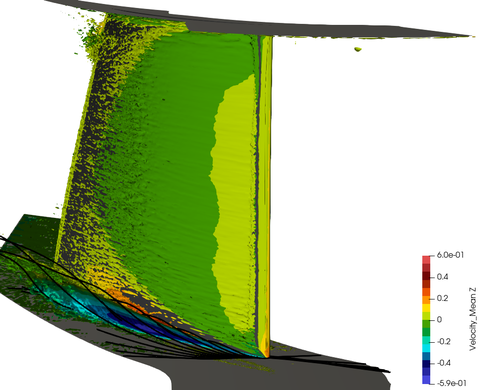Scale resolving numerical investigation of the function of circumferential grooves in subsonic axial compressor stages
Current developments in the field of axial turbomachinery, in particular axial compressors, towards increasing pressure ratios and a reduction in the number of blades and stages are leading to ever larger radial tip clearances. This has a whole series of aerodynamic consequences that have a negative impact on losses and the stable operating range. A promising approach that addresses the stability problems is the introduction of casing treatments (CTs) in the casing wall. Of the various approaches, circumferential grooves in particular represent an attractive variant of CTs in many respects. The use of such CTs has the potential to significantly extend the stable operating range, but can also lead to increased losses and therefore requires closer consideration.
However, the current industry standard for the simulation of turbomachinery is two-equation Reynolds-Averaged Navier-Stokes (RANS) models or Unsteady RANS (URANS) methods. It is difficult to reliably predict strongly anisotropic turbulence, large-scale vortex structures and transition effects. Large-Eddy Simulations (LES) or hybrid LES/RANS methods have the fundamental advantage of resolving turbulence and can help to improve the understanding of the mechanism of circumferential grooves, taking into account all turbulence, rotation and geometry effects. As a result, such methods are increasingly finding their way into industrial practice despite the considerably higher computational effort involved. Currently, however, turbulence-resolving approaches do not always achieve the best possible results. There is therefore a need for improved methods for turbulence-resolving simulation in the turbomachinery sector, both in terms of computational efficiency and accuracy.
In this context the project has two main objectives. Firstly, to understand the physical machnism of circumferential grooves and the subsequent behavior of the rotor flow at off-design operation points. Secondly, turbulence resolving simulation methods are to be further developed. The transition from the finite volume approach to high order methods represents a crucial step here. In the spectral element code HiSPEET, hybrid LES/RANS methods and selected LES sub-grid scale models are implemented, adapted to the spectral element methodology and further developed. The potential of the various methods is systematically investigated and best-practice recommendations are developed.
The activities and objectives described here take place within the framework of a DFG-funded partner project. The other project partner carries out experimental measurements of the CT compressor configurations under investigation as well as further simulations with RANS/URANS. In this way, physical and methodological findings are decisively advanced.
| Cooperation | |
| Funding | DFG under Grant FR1593/15-1 within the package proposal PAK948 |
| Contact |
Dipl-Ing. Moritz Kreuseler |

